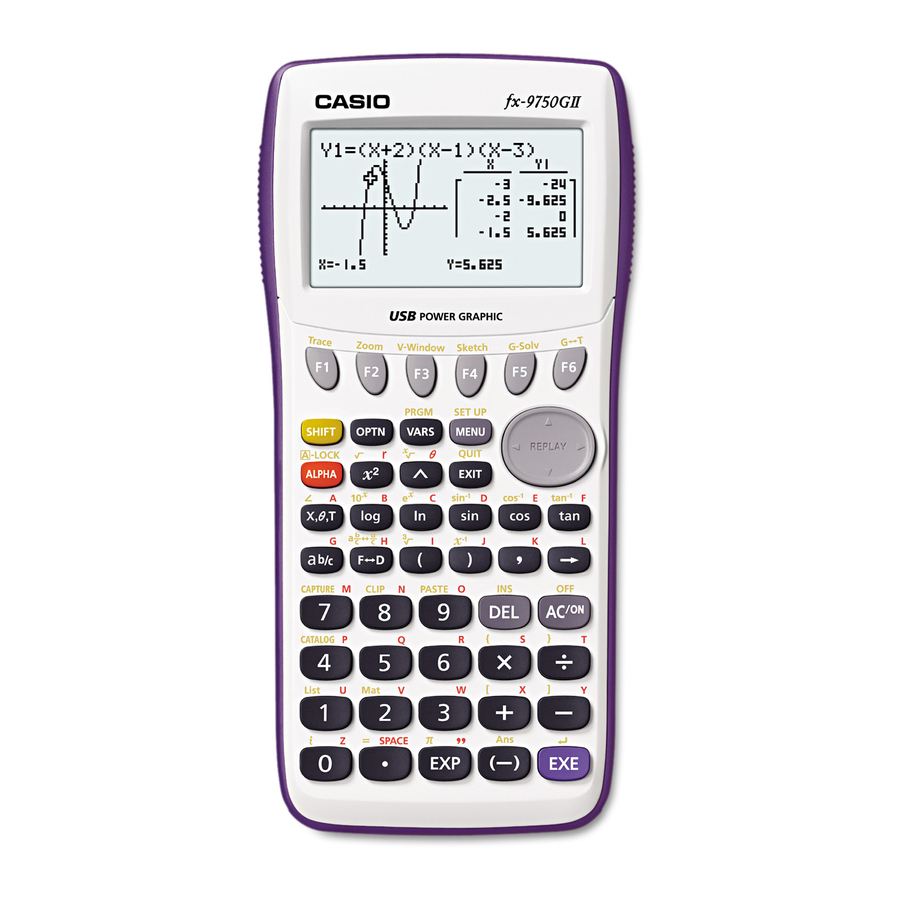
Casio fx-9750GII Quick Start Manual
Hide thumbs
Also See for fx-9750GII:
- User manual (412 pages) ,
- Getting started (87 pages) ,
- Quick reference manual (16 pages)
Advertisement
Quick Links
www.casioeducation.com
QUICK START GUIDE
fx-9750GII
Selecting the RUN-MATRIX
perform general computations and arithmetic.
The function keys allow you to access the tab (soft
key) menus that will come up at the bottom of the
u
screen. When an
appears above the
selecting
will offer more on-screen choices.
u
The
key displays every mode the calculator has.
p
To select a mode, you may
and press
or press the number or letter in the
l
lower right hand corner of the icon.
The
key operates like the back arrow on a web
d
browser; it will take you back one screen each time
you select it. The
key will not take you to the icon
d
menu.
The
key is a toggle key that will change answers
x
or entered numbers back and forth from decimal to
fraction form.
The
key will power the unit on. To turn the unit
O
off, press the yellow
L
The
key is used to obtain a fraction bar. To obtain
z
a mixed number, press
z
number.
The
key executes operations. When data is
l
entered, the
button must be pressed to store the
l
data.
icon will allow you to
key,
u
to the desired icon
$B
key, then
key.
O
after inputting the whole
Advertisement

Summary of Contents for Casio fx-9750GII
- Page 1 QUICK START GUIDE fx-9750GII Selecting the RUN-MATRIX icon will allow you to perform general computations and arithmetic. The function keys allow you to access the tab (soft key) menus that will come up at the bottom of the screen. When an...
- Page 2 The following explains the meaning of each icon on the fx-9750GII icon menu Icon Menu Name Description This icon menu is used for general computations, including absolute value, logs of any base, RUN-MATRIX summation, derivatives, integrals, and matricies. This icon menu is used to perform single-variable (standard deviation) and paired variable...
- Page 3 Display, select (Fix) and enter the desired amount of decimal places followed by l. For this example, 3 decimal places are used. Note: Every icon’s Set Up menu is accessed in the same manner. • LpNNNNNNNNNNNq3ldlx fx-9750GII Quick Start Guide...
- Page 4 Note: Calculations can be performed with complex numbers and answers can be displayed in a+bi form. 7. To calculate 3+4i ; enter the following from the initial RUN screen: • iew(3+4q)l 8. To calculate (-3 + 2i ) + 15i; enter the following: • ie(n3+2q)+15ql fx-9750GII Quick Start Guide...
- Page 5 To quickly change your window, you can utilize the Replay arrows. Specific changes can be made to the viewing window by selecting V-Window (e). To analyze features of this graph (roots, maximum and minimums, y-intercepts, intersections, determine coordinates, and integrals), select y(G-Solv). fx-9750GII Quick Start Guide...
- Page 6 5. q(y-calculation): What is the value of y when x is -5? 6. w(x-calculation): What is the value(s) of x when y is 1? 7. e(integral): Determine the integral value from (0, 3) for the function Y1=2x - 5x - 3. fx-9750GII Quick Start Guide...
- Page 7 3. However, you can manually enter a number anywhere in the x-column of the table and press to see the corresponding y-value (including fractions, decimals, even π). You can insert and delete rows in this view by pressing e(ROW). This is a quick way to customize your tables. fx-9750GII Quick Start Guide...
- Page 8 TABLE icon. Scroll down to Dual Screen, select q(T + G), d, then u(TABL). If you manually entered values to the previous table that you still want displayed, you can re-enter them here, then press to see the graph of that table. fx-9750GII Quick Start Guide...
- Page 9 3. The initial default graph is a scatter-plot. To change the type of graph you would like to use, press q(GRPH), u(SET), and to Graph Type:. For this set of data, we will make a histogram, press u, and then for histogram. fx-9750GII Quick Start Guide...
- Page 10 7. For paired variable data, use the following: Enter List 1 first, and then to begin entering List 2. The cursor will automatically move to the beginning of the next list. fx-9750GII Quick Start Guide...
- Page 11 For this example, we will use y = ax + b. 11. From this screen, select y(COPY) to copy and then paste the regression equation into the initial Graph screen or select u(DRAW) to show the linear regression. fx-9750GII Quick Start Guide...
- Page 12 To enter this system of equations (already in standard form), input the following: • • • There are four options at the bottom of the screen, press q(SOLV). The solution to this system is fx-9750GII Quick Start Guide...
- Page 13 3 and press q(SOLV). 4. The default setting is for real numbers; to change the display to a+bi form, press for the Equation SET UP menu, highlight Complex Mode, select w(a+bi), d, then q(SOLV). fx-9750GII Quick Start Guide...
- Page 14 6. Find the radius (to the nearest hundredth) of a sphere, whose volume is 3705.97 cm . To enter the formula , input the following in to the calculator: • qBa2L.4z3Lca6^3l • Highlight V= and enter 3705.97l • Press u(SOLV) fx-9750GII Quick Start Guide...
- Page 15 2. For example, you can now examine the line of symmetry for this parabola and the equation of that line will be displayed. To see the line of symmetry, press w(SYM). You can continue to analyze different areas of this graph and the line of symmetry will still be displayed. fx-9750GII Quick Start Guide...
- Page 16 See the complete line of Casio calculators www.casioeducation.com fx-9750GII Quick Start Guide...














Need help?
Do you have a question about the fx-9750GII and is the answer not in the manual?
Questions and answers